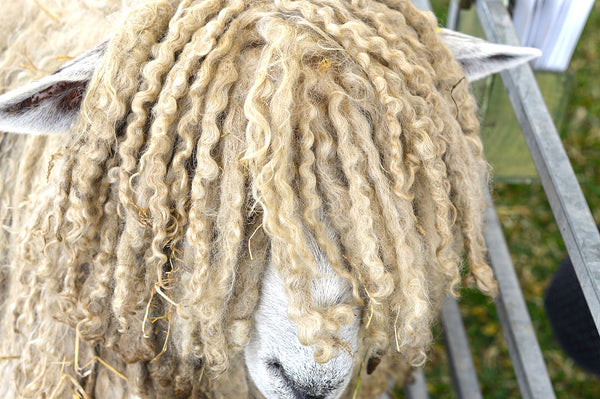Know Your Fiber: Lincoln Wool
Posted on August 01 2019

Located in eastern England, Lincolnshire has been renowned throughout history for their namesake breed, Lincoln sheep. Once the largest known breed of sheep in the western hemisphere, Lincoln wool was quite popular for its luster and remarkably long staple length. With the majority of this breed raised just a short distance from the North Sea, the wool from these sheep were very important to early English exports of both wool and fabric.
The origin of the Lincoln sheep almost certainly starts with the occupation of England by the Romans starting in early 40 AD. Based on evidence from archeological digs, it has been fairly well established that the native sheep of England and the rest of northern Europe had short wool coats and short tails. Longwooled and longtailed sheep arrived with the Romans as they expanded their empire into the British Isles, and the earliest evidence of longwooled sheep in England comes from a 2nd century child’s grave in nearby Cambridgeshire that contained clay figurines of both shortwooled and longwooled sheep. It is thought that these longwooled sheep brought by the Romans were the ancestors of the Lincoln and other longwool breeds in England.
Centuries and generations of sheep later, the next surviving depiction of longwooled sheep appears in a psalter from the 14th century. Commissioned by Sir Geoffrey Luttrell, the lord of Irnham in Lincolnshire, an illustration in the Luttrell Psalter clearly shows longwooled sheep being milked inside of an enclosure. It is thought that this is the earliest depiction of Lincoln sheep, and along with other evidence has led some researchers to believe that Lincoln sheep that may have provided the foundation of all the current English longwool breeds.
By the 1600s, Lincolns were widely known across Europe as being the largest of all sheep breeds. In addition to their size, Lincolns also had a good, heavy fleece that was important to the wool and fabric trade. Worsted cloth woven from the wool of Lincoln sheep, and named after the village of Worstead in which it was originally woven, was an in-demand trade good. Lincoln wool was considered ideal for making worsted cloth, which required a finely spun yarn in which the fibers had been carefully combed to lay parallel to each other. Lincoln wool was thought to be perfect for the rough combing process, and its length was made it sought after for making finely spun and smooth yarn.
Lincoln wool was also valued for being a particularly lustrous wool; Lincoln wool practically glows with color when dyed. Like many longwools, the broad scales on the fibers means that it reflects light in a way that other wools do not. In the letters of the Paston family written during the 1400s-1500s, there is reference to a shoulder covering, “of fine worsted cloth, which is almost like silk.” That is no small compliment, especially given popularity and value of silk at the time. However, given the difference in micron widths between silk and Lincoln wool, it is very likely they were referring to the luster and shine of the wool being as silk, rather than its lightweight silkiness.
The Lincoln was an important and substantial supplier of wool. However, by around the mid-1700s sheep that were dual-purpose – that is, sheep that could produce good quantities of both wool and meat —were becoming increasingly popular as more and more farmers moved towards meat production. The meat from Lincoln sheep had never been particularly well thought of, and so breeders began to work on improving the Lincoln for this purpose. Despite the changes to the breed during this period, the Lincoln sheep retained their impressive long locks and overall size. Breeders were also careful to preserve their ability to produce large quantities of wool, with Lincoln sheep described by Matthew Milburn in 1853 as nothing less than, “a living square of wool.”
During the mid to late 1700s, well-known breeder Robert Bakewell began a program in which the Lincoln was bred other sheep to develop the New Leicester, or Dishley, breed of sheep. These sheep in turn were bred with Lincoln ewes over the 1800s to develop the Improved Lincoln, the breed upon which today’s Lincoln are based. These improved Lincoln sheep began to be exported to the rest of the world, and it turned out there was a strong market for them. The improved Lincoln sheep first appeared in Canada in the early 1800s, and was in the United States by 1825. These Lincolns were exported to the rest of the world as well, such as South America, Australia, and New Zealand. While some purebred Lincoln flocks were kept, many were also used to create new breeds of sheep including the popular Corriedale, Polwarth, and Targhee.
With heavy demand for Lincoln sheep, many Lincoln shepherds in the U.K. began breeding for export during the 1800s and early 1900s, as well continuing to raise them for wool and meat. By the early 1900s, there were around 500,000 Lincolns in the U.K. However, the export market began to fade as the 1900s went on. As other countries gained breeding stock, they raised additional Lincoln sheep for themselves and no longer needed to depend upon the U.K. stocks. The wool market also began to fade during the 1900s with the advance of artificial fibers. By the 1970s, there were only 15 Lincoln flocks with about 500 ewes left in the U.K.
Fortunately for the Lincoln sheep, there was a significant renewal of interest in the fiber arts during the 1970s. Local Lincolnshire spinners and weavers began promote Lincoln wool, leading Lincoln shepherds to begin promoting the unique characteristic of their wool as well. The market began to grow again, largely driven by those with an interest in the fiber arts and handicrafts. Due to the growth of fiber arts interest over the past several decades, there are now around 1500 ewes in the U.K., with an increase in flocks in the United States, Canada, Australia and New Zealand as well. The Lincoln sheep is not out of the woods yet, though; with their relatively small numbers throughout the world, The Livestock Conservancy has listed the Lincoln sheep as a Threatened breed.
You can help save this important heritage breed by creating with Lincoln wool! The wool can grow between 8-15 inches per year, which means that Lincolns are often sheared twice a year to keep the staple at a manageable 5 inches or so for spinning. With a micron count between 36-40, Lincoln wool is a heavier wool that tends to be best suited for outerwear, rugs, and pillows. One of the most popular features of Lincoln wool is that it is extremely lustrous, with a sheen that is hard to beat – when dyed, Lincoln positively shines with color. The locks are also sometimes used as hair for dollmaking or used as gorgeous curly pile in woven rugs.
Interested in trying out some Lincoln for yourself? We have it! Check out our Lincoln top in our shop, and start you next project.
Photo by Nhojjohn [CC BY-SA 3.0 (https://creativecommons.org/licenses/by-sa/3.0)]

Follow US